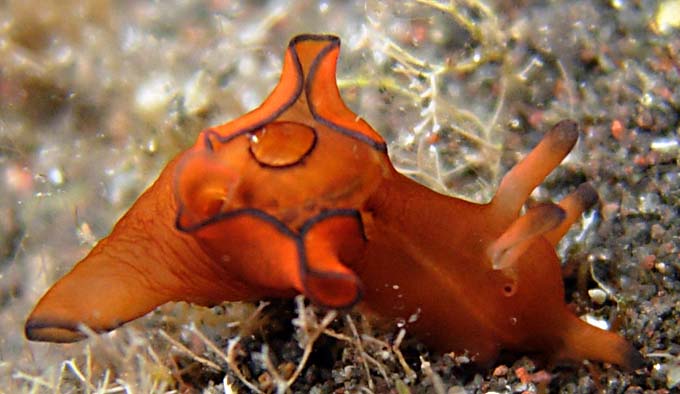This species has been observed on Reunion, Mauritius, Mayotte and Madagascar Islands
|

|
|
| Showing species characteristics... | Photo Philibert Bidgrain |
|
|
Marina Poddubetskaia Mayotte, Passe en S, buoy n° 3, 3-4 m, 5 November 2003, size : 15 mm Showing species characteristics...
|
Sophie Darnis Showing species characteristics... Reunion, La Barge, Saint Paul, 24 m, 7 November 2009, size : 20-25 mm
|
 |
 |
Christophe Cadet Showing species characteristics... Reunion, Etang salé, on the rocky coast, less 1 m, 9 February 2010, size : 10 mm
|
See more about : Aplysia parvula variability in Southwest Indian ocean
See more about : Sightening and mating periods
Remarks :
Identification confirmed by Bill Rudman and Nathalie Yonow
Synonymous : (according Worms)
- Veryu numerous synonymous, see worms
Bibliographic data :
This seaslug has the typical oral tentacles at the front of the head, on either side of the mouth and the smaller rhinophores just above the eyes
Parapodia enlarged, upstanding and strongly undulated, originating separately anteriorly and meeting as a low rim on the tail
The parapodia enclose the mantle cavity in which the fragile plate-like shell is found.
There is a large black-edged hole (foramen) in the middle of the mantle, through which we can see the shiny brown shell. In most species of sea hare the foramen is very small, often reduced to a pore on the tip of a slightly raised papilla.
In juveniles, the shell is completely external, like in a snail. As they grow, the mantle tissue from inside the shell extends out from under the shell and folds over gradually covering much of the upper surface.
There has been a lot of interesting research on feeding in this species and it seems that some species of red algae are preferred over others, and the preferred ones contain metabolites which are stored by the sea hares for their own defense
Emits purple dye when disturbed.
They lay a tangled, greenish-brown egg mass. The eggs hatch in about seven days in the laboratory.
Material examined by Nathalie Yonow ( see reference/publications).
Mauritius, Tamarin, reef flat zonz ; 9 October 1985 ; 4 specimens : 8, 11, 20 and 30 mm.
References :
Bill Rudman Seaslug site : Sea Slug Forum : Aplysia parvula
Nudipixel Aplysia parvula
Publications :
Morch, O.A.L. (1863). Contributions a la faune malacologique des Antilles danoises. Journal de Conchyliologie 11 : 21-43.
Yonow, N. and Hayward , P. J. (1991). Opistobranches de l'île Maurice, avec la description de deux espèces nouvelles (Mollusca : Opistobranchia) Revue française d'aquariologie herpétologie, 18 (1), 1-30
Other photos of Aplysia parvula :
 |
Christophe Cadet Réunion, Etang salé, on the rocky coast, less 1 m, 24 October 2010, size : 15 mm An original pattern, large white spotss with tiny white dots |
Philibert Bidgrain Reunion, Hermitage lagoon, less 1 m, 24 September 2010, size : 15 mm for the larger Probably a Mating behavior... |
 |
 |
Philibert Bidgrain Reunion, "Kelonia center", at Saint Leu, 8 December 2006, size : 30 mm A tiny white dot form : Between the two parapodia (a), there is a very large hole or foramen in the mantle (b) , through which we can see, and touch, the brownish shell (c). |
Alain Barrére Reunion, "Souris blanche" lagoon at Trois Bassins, less 1 m, 4 November 2006, size : 10-20 mm A tiny white dot form : with : |
 |
 |
Marina Poddubetskaia Mayotte, "Passe Bandrélé", Bandrélé, 8 m, 11 November 2003, size : 15 mm A tiny white dot form : with :
|
|
Sully Bachel Reunion, La Barge, Saint Paul, 24 m, 23 October 2009, size : 20-25 mm The same specimen than Sophie Darnis, but two weeks before.... A large white spots form : |

|
 |
Marina Poddubetskaia Mayotte, "Passe Bandrélé", Bandrélé, 9 m, 11 November 2003, size : 12 mm A large white spots form : - The color is in shades of pale brown, dotted with large white spots |
Marina Poddubetskaia Mauritius, "Jardin de Corail", Pereybère, 17 m, 18 October 2002, size : 15 mm Dark brown form : |  |
 |
Florence Trentin Mohéli, Sambia, 13 October 2006, size : 10-12 mm Dark brown form : - This tiny Aplysia has a blue rim to the parapodia, rhinophores and oral tentacles |
Marina Poddubetskaia Most specimens from Mayotte of Aplysia parvula found by Marina were found inside this red alga. There has been a lot of interesting research on feeding in this species and it seems that some species of red algae are preferred over others, and the preferred ones contain metabolites which are stored by the sea hares for their own defense |
 |
 |
Christophe Cadet Réunion, Etang salé, on the rocky coast, less 1 m, 19 Octobrer 2012, size : 10 mm Pattern brown-orange : An original pattern for this species in our area. |
More photos from Indian Ocean
See more about : Aplysia parvula variability in Southwest Indian ocean
Reunion, Aplysia parvula take off, at Saint Leu, by Philibert Bidgrain
Reunion, a dark brown form of Aplysia parvula, at Saint Paul, by Sophie Darnis
Mauritius, dark brown form with blue margin of A. parvula, at Pereybère, by Marina Poddubetskaia
Mayotte, dark brown form with blue margin of Aplysia parvula, at N'gouja, by Marina Poddubetskaia
Reunion, dark brown form of Aplysia parvula, at Etang salé, by Christophe Cadet
Reunion, pink and black pattern of Aplysia parvula, at Etang salé, by Christophe Cadet
Reunion, head detail of Aplysia parvula tiny white dot form, at Etang salé, by Philibert Bidgrain
Madagascar, Aplysia parvula, at Nosy Bé, by Alain-Benoît Rassat

